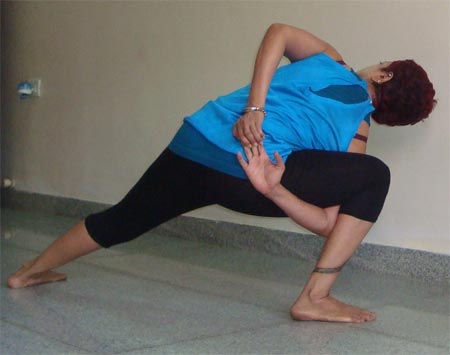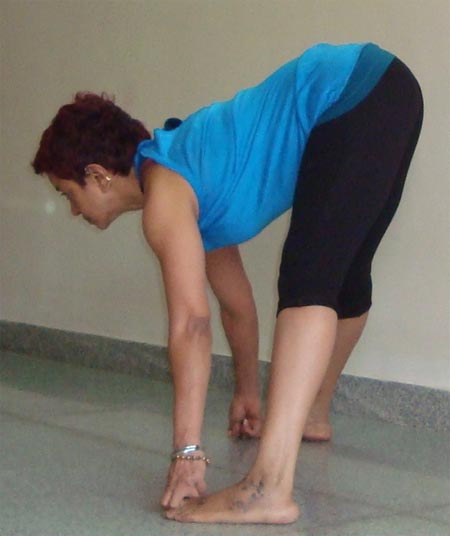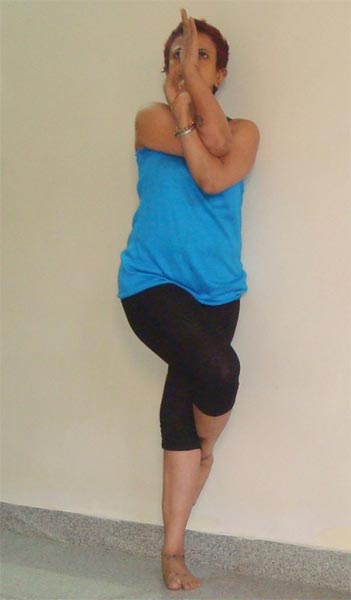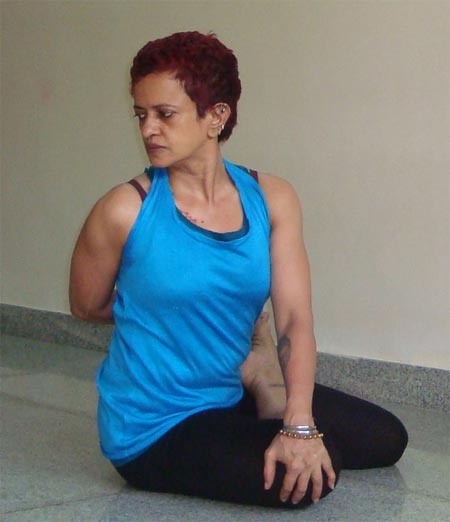
Shameem Akthar, yogacharya trained with the Sivananda Yoga Vedanta Center, gives you five poses to improve your flexibility.
Though all different forms of exercise are great, yoga is amongst the few which offers the body flexibility too. In fact, martial arts experts use yogic moves to build in this element into their practice. Flexibility is important for several reasons. One, flexibility facilitates easy joint movements and is an indicator of joints that are healthy and well lubricated.
Flexibility also means the large muscle groups have extended their range of movement and elasticity which in turn gives them the 'bounce' factor, helping you recover from falls, or injuries faster and more completely.
Flexibility also means that the subtle muscle tissue called fachsia is toned and in good form. In fact, flexibility is also an indicator of the predominant muscle fiber you have developed: flexibility is associated with slow -twitch muscle groups. The slow-twitch muscles help with endurance activity and stamina. They are good muscle fibers to cultivate unless you are into fast, sporty activity that need spurts of speed and energetic movements (like running, competitive games, fighting etc), in which case you would need to develop fast-twitch muscles. The latter are lighter in colour, get less oxygen, and are stiffer in form. Slow-twitch muscles are well oxygenated, are red in colour and have good blood supply. They also heal faster, due to these reasons.
In the nascent psychosomatic sciences, flexibility of the body is also an indicator of flexibility of the mind, which may be a cherished quality to cultivate.
While using yoga to develop flexibility you may need to start off with simple stretches, and move into the more challenging ones after a few weeks of practice. Initially start off by doing the same move several times. After some time, as stamina develops, you may extend the duration in the final pose, holding it just once, but longer. Also, moving the mental focus over the body, managing the breath, and learning to shift weight will bring a meditative focus into the practice which will further help you develop the flexibility of both body and mind.
Points to note:
For more of Shameem's yoga writings visit https://jaisivananda.blogspot.com. Shameem's second book Yoga in the workplace, with photographs by ace photographer Fawzan Husain, is now available at online shops and bookshops across the country. It is also available as e-book, with Kindle, Amazon.
Disclaimer: This column just shares the columnist's passion for yoga which is ideally learned under the guidance of an expert

Parivritti Konasana (Side twist angle pose)
This is also called the Baddha konasana (locked angle pose). Stand with legs a meter apart, right foot pointed to right side, left foot flared slightly in. Inhale. Exhaling lunge to the right side, so the right knee is bent, and the back leg remains straight. Try to keep the left foot flat on the ground behind. Continue normal breathing. Pass the right arm from the front of the right thigh, under the right knee. Then pass the left hand. Hold both hands as shown. Twist at the spine to facilitate this hands' lock. Look either to the wall ahead, or turn over to look at the ceiling (the latter move involves a keen sense of balance, and may not be attempted by beginners). Hold for a few seconds. Release, to repeat for the other side.
After a few weeks you may increase duration in the final pose to 15 seconds or more.
Benefits:
Improves balance, corrects postural defects, builds flexibility all over – the back is toned all over, the legs are stretched and become supple, the arms are stretched right to the finger tips. The torso is twisted from all directions. It is a complete stretch that covers the entire body.
Used to deal with digestive problems, postural defects and the uro-genital system.

Uttanasana (Complete stretch, easy variation)
Stand straight, legs a meter apart. Inhale, stretching hands overhead. Exhale, reach them down, pushing the hips back, as shown. Keep looking ahead, hold the big toes with either hand. Push the hips back, so the stomach caves in. Look ahead, so the neck is stretched. Continue holding for a few seconds. Release pose. Repeat thrice. Increase duration in the final pose, after few weeks.
Benefits:
Opens the back and makes the entire spine elastic, right up to the neck region. Flexes the major joints in the legs and arms. The hips is worked out and toned, the arms and legs are stretched to the maximum. All forward bends and leg-toning exercises are powerful ways to de-stress.

Garudasana (Eagle pose)
Stand up straight. Bend the right hand at the elbow, pass it over bent left arm, at the elbow. Twists arms as shown, to bring palms together. Similarly, fold the right leg at the knee, passing it over the left, bending the latter lightly at the knee. Pass the right leg around the left, twisting the former, as much as you can. Hold the pose as long as you can. Release, to repeat for the other side.
Benefits:
Posture and balance are improved. Tones arms and legs, and makes them super flexible. Is used to open up the upper back, facilitate deeper breathing. The squeeze at the hip region works the urogenital system, helping deal with problems related to this region.

Bharadwajasana (Sage Bharadwaja pose)
Sit on your heels, with the hips resting on them (in the basic meditative pose called vajrasana or thunderbolt). Lift the right foot, placing it high on the left thigh, as shown. Pass the right hand behind to hold the right big toe. Inhale. Exhaling, twist over the right shoulder. Hold the twist for 10 seconds, breathing deeply and continually. Release, to repeat for the other leg.
Benefits:
This poses makes the spine and the hips flexible. Arms and legs are also stretched to the maximum. It is used to treat problems of the uro-genital system, boost respiratory capacity. All twists are also powerful detoxifying poses.

Trikonasana (Triangle pose)
Stand with feet a meter apart. Right foot is flared to right side, left turned lightly in. Both hands are loosely at the side. Inhale, raising the hands, to raise the left hand overhead, as shown, and the right hand on right thigh.
Exhaling, slide the right hand along the right thigh, as low as you can. Ensure your hand is only resting lightly on the thigh. Continue normal breathing. You may either focus on the raised left hand, or look at the wall ahead. Ensure body is aligned. Hold for a few seconds. Release the pose, to repeat for the other leg.
After a few weeks increase duration in the final pose to half minute or so.
Benefits:
Improves balance, flexibility of arms, legs, especially inner thighs and hips. The spine is also flexed transversely.
Is used as therapy in several ailments, including chronic ones, like blood pressure, diabetes, spinal problems, respiratory ailements.